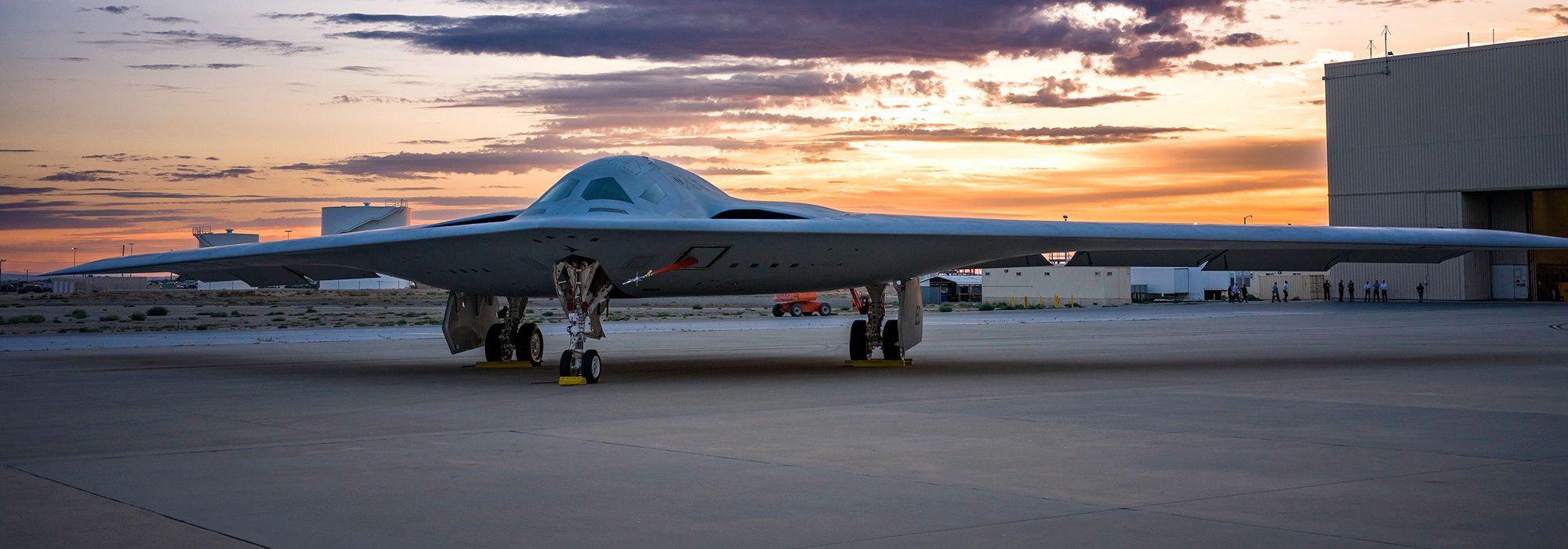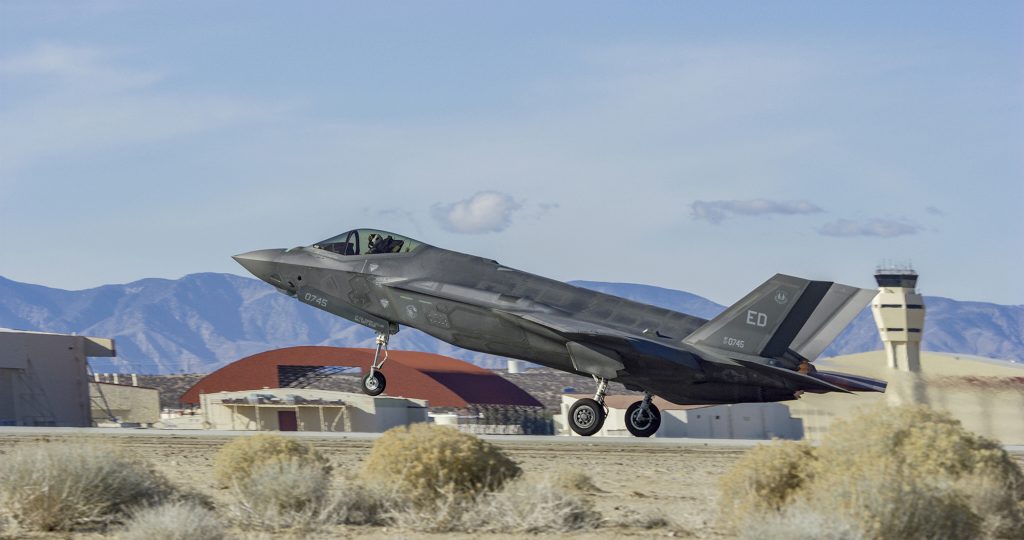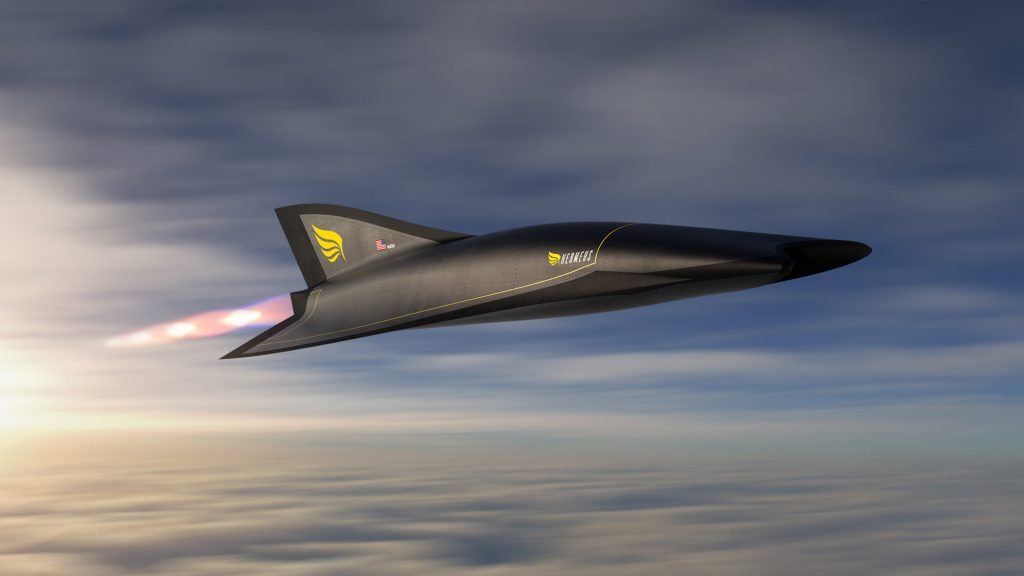Edwards Air Force Base might not have been this busy since the 1960s.
The first B-21 Raider took off at dawn from Palmdale, Calif., Nov. 10 on its premier flight, touching down at nearby Edwards Air Force base more than 90 minutes later, after using a circuitous route to check out basic handling qualities. Edwards will be the bomber’s home for the next several years, as pilots and engineers test and assess its performance.
The Raider is one among a surge of test projects for which Edwards has been preparing, ensuring a pace of operations there not seen since the test heyday of the 1960s. Among the new arrivals and other imminent test programs:
- The B-21 Raider bomber.
- The T-7A advanced jet trainer, which arrived at Edwards only a day before the B-21 from St. Louis. It’s the first of five dedicated T-7A test aircraft that will be put through its paces over the next two years.
- The B-52 test force will grow to eight or more aircraft, as Stratofortresses on loan from Air Force Global Strike Command (AFGSC) arrive to evaluate its new radar, engines, weapons, and a series of navigation and communications upgrades.
- The X-62A, a highly modified F-16 that will test autonomy functions.
- The new F-15EX fighter.
- Collaborative Combat Aircraft (CCAs), intended to be autonomous or semi-autonomous partners for crewed fighters.
- The AIM-260 Joint Advanced Tactical Missile, the next-generation, long-range dogfight missile for Air Force fighters.
- The Next-Generation Air Dominance (NGAD) fighter, a super-stealthy fighter to succeed the F-22
- The F-35 and its Block 4 upgrades, as well as a new version of its F135 engine.
- The Hypersonic Attack Cruise Missile, an air-breathing, Mach 5-plus weapon.
That list doesn’t include ongoing test projects to evaluate aircraft upgrades or other new munitions, most of which will be evaluated at Eglin Air Force Base, Fla. Many of the new programs are the result of Air Force Secretary Frank Kendall’s Operational Imperatives initiative, which seeks to put new, more relevant hardware in the hands of Airmen as quickly as possible.
Maj. Gen. Evan Dertien, commander, Air Force Test CenterIt’s an awesome time to work in the test enterprise … there’s cool stuff going on.
“We’re busy,” acknowledged Maj. Gen. Evan C. Dertien, commander of the Air Force Test Center, in an October interview. Without significant new financial or human resources, the Air Force Test Center is training its workforce for new kinds of testing and applying new technologies to the task.
Dertien’s enterprise comprises test aircraft, ground test facilities, test ranges, the data infrastructure, and people. Asked if his resources are robust, stressed or overwhelmed, he said “it depends on the program.” Some “are stressing our fleet a little bit more, some programs are stressing the technical capabilities of our people. Other programs are obviously stressing our facilities,” he noted.
But stress is not necessarily all bad. “It’s an awesome time to work inside the test enterprise,” he said. “Most people are very excited to show up to work because there’s cool stuff going on.”
Dertien’s test aircraft fleet is being modernized. The existing F-35 test fleet, for example, is “getting pretty long in the tooth” and will be upgraded with as many as nine factory-fresh aircraft dedicated to the test mission.
“It’s one thing to get an aircraft, but it’s another thing to get the right instrumentation in there,” Dertien said. “So we’re making sure that we have the instrumentation needed.”
The aircraft will be outfitted with specialized test gear right on the production line at Lockheed Martin, he said. For other kinds of F-35 testing, Edwards will use operationally representative aircraft from Air Combat Command or the Navy, borrowing planes as needed. The F-35 test fleet on the ramp now is “very diverse,” he continued, and comes from all the U.S. services as well as partner countries.
F-35 testing is currently focused on the Tech Refresh 3 upgrade, which swaps out the F-35’s processor with a much more powerful unit that makes possible the capabilities inherent to the coming Block 4 upgrade. That will deliver more powerful electronic warfare capabilities among more than 50 improvements.
TR-3 is “our No. 1 focus right now,” Dertien asserted.
But it is the bomber test contingent that is “probably where our fleet is stressed the most,” he said. “The most loaner aircraft that we have right now is in the bomber fleet. … We’re supporting bomber modernization, with B-52 engine upgrades, the cockpit upgrades, and also all the hypersonic [weapons] development.”
As a result, the bombers represent “our biggest workload,” Dertien said. “The Air Force has done a great job of providing us extra resources for what is … a couple of years of surge. … Once we get through some of these programs, we’ll go back to our normal size.”
Boeing is developing a new “agnostic” pylon assembly for the B-1 called the Load-Adaptable Modular (LAM) pylon, which can accept a variety of new munitions. The Test Center and AFGSC are interested in the hardware and the Air Force has provided some money to evaluate it, because the test demands on the B-52 are also stressing GSC. With eight B-52s in testing, and another 10 to12 in depot or repair most of the time, only 56 to 58 of the 76 B-62s will be available for operations. And while the B-52 has a nuclear deterrence mission, the B-1 doesn’t.
CCAs
Brand new in the pipeline is the Collaborative Combat Aircraft (CCA) initiative, which poses a new kind of test effort, Dertien said. Autonomous aircraft have been tested before, but the scale and intensity of the effort is new, as are the challenges of operating crewed and uncrewed aircraft together.
“We’re still learning” how to test CCAs, he said. “My focus right now is making sure that the test enterprise is ready to test autonomy.”
That will change workforce training and ensure that ranges, policies and procedures are ready for challenges posed by CCAs.
As ACC Commander Gen. Mark D. Kelly has pointed out consistently since CCAs first appeared in the Operational Imperatives, the FAA has yet to develop rules and policies which would allow CCAs to transit civilian airspace, and that has to happen if they are to be truly integrated with the combat air forces.
Kendall has posited a force of at least 1,000 CCAs, with the first ones ready for duty within the next six years. That timeline demands a robust and fast-paced test program.
While Dertien said he has all the necessary specialists for CCA testing, the challenge will be integrating their efforts.
“I have people who know” how to test uncrewed air vehicles, autonomy, and fighter tactics, he said. “But now we’re going to have to bring [those capabilities] all together to test something like the CCA.”
In preparation, the Test Center is pulling together all the work done in recent years on the Kratos XQ-58 Valkyrie and the Air Force Research Lab’s “Skyborg” aircraft-agnostic autonomous flight algorithm. It’s also set up a program called VENOM (Viper Experimentation and Next-gen Operations Model), a half-dozen F-16s that will explore how to tactically and operationally integrate uncrewed and crewed fighters working in close proximity.
The X-62 Variable In-flight Simulation Test Aircraft (VISTA) is “helping us advance autonomy” and define the needed workforce, Dertien said. It is the ground floor of fighter integration, he added.
The test enterprise will be ready “when that first CCA lands or is brought here,” he said, such that “we’re ready to test the autonomy and integrate it with existing systems like the F-22 and the F-35.”
Col. Douglas P. Wickert, commander of the 412th Test Wing at Edwards, noted that CCAs will also be nodes in a wider network, which means integrating them with the nascent joint all-domain command and control (JADC2) system. They cannot be comprehensively tested in isolation, he commented.
“Increasingly, these are all interactive systems,” he observed. “One of the things that we’ve done in the test enterprise is create recurring opportunities to bring a lot of things together.” Edwards is setting a “stage” on which the Air Force can integrate CCAs with crewed aircraft and the Advanced Battle Management System (ABMS), and allow testing in “a very complex, realistic environment.”
Preparing for the influx of many new programs means Dertien’s team must work smarter and get better utility out of the assets on hand.
MISSION CONTROL
A manpower-intensive aspect of most test flights is the control room—think Mission Control at NASA—with a score of experts monitoring everything from dynamic loads on the test article to chase aircraft, telemetry links, and watching for stray aircraft or vessels entering the test area which could interfere with the activity.
“Two [or]… three years ago, I would have really highlighted control rooms as being the constraints” on testing, Dertien said.
“That was really due to all the different classifications that were built up and driven from the program office,” he said. It was time-consuming to run a highly secretive test and then reconfigure the control room for the next program.
“We made a lot of investments to … be able to turn the control rooms much faster,” he stated.
“We’ve also made a lot of investments that are allowing us to do distributed test operations. So I can have a control room here at Edwards supporting a test in St. Louis,” where the F-15EX is built, “or a control room here at Edwards supporting a test down in Eglin. So I think we’re making much more efficient use of our existing control rooms.”
They are no longer a limiting factor, Dertien said.
Wickert said Air Force testing is going through “the most significant modernization I think that maybe the Air Force has ever … lived through” and if the test enterprise is going to manage “the tsunami of programs in the future,” it can’t do business as it has.
“We would need about three times as many people. And although we’re going to get a modest increase, we will never get that much,” according to Wickert.
Consequently, the enterprise is using “some of the modern data analytic tools” that the younger workforce is already comfortable with “and they’re hungry to do it.”
When it comes to “taking data and turning that data into information and information into knowledge, there are some modern practices that I think are … going to make us much more efficient, much faster.”
The Test Center has “decades” of data that can be used to train an artificial intelligence to evaluate new systems more rapidly and deeply, Wickert noted. “In the past, we’d deliver a … 500-page test report and that took people a lot of time to type.” But now the system can “deliver integrated data products. Because, when you create the test report,” it’s answering the question “you thought the program office was asking.” Now, with an integrated data report, “they can always come back and ask … different questions and the data is there to go do that.”
Across the Test Center, “we’re looking at creative new ways to provide products that are really less work, and also more valuable to the program offices and the customers we support.” It’s doing more “with the existing data that we already have.”
Edwards has a chase fleet of mostly F-16s. Crews in chase aircraft watch the test article for problems or changing conditions; sometimes they photograph or film the test, and they can also watch for stray aircraft in the area. Dertien said the chase fleet is “pretty well resourced,” and not a limiting factor, but “with the B-21, with T-7s and all the bomber modernization, the hypersonics … it does stress that fleet.”
The Test Resource Management Center (TRMC) is moving to repurpose RQ-4 Global Hawks retiring from the intelligence, surveillance and reconnaissance mission and turn them into high-flying telemetry capture and relay platforms, Dertien said.
This will “provide more instrumentation on our … larger ranges that are over the water, where we test hypersonics,” he noted. The effort will increase “our airborne and space-based instrumentation capabilities. So that’s a program that continues to evolve, but primarily that’s led by TRMC right now, that are making those investments in the Global Hawks to instrument and operate those vehicles to support hypersonic test.”
The concept of operations calls for three or four Global Hawks to collect data over the large areas covered by hypersonic systems, which typically fly over sea ranges because of their speed, sonic booms and the fact that they usually are not recoverable once their fuel or momentum run out.
The innovation will add great new flexibility, Wickert said.
“When we used to rely on the Navy for telemetry…we would have to actually start [deploying] the ships two weeks … prior to a test and just have them on station” to establish the telemetry capture across the range.
“And of course, if something happens to the system under test in those 14 days,” then the test opportunity is lost, Wickert said. With the Global Hawks, “in 12 hours you can have them on station” with the telemetry ready to go.
Just as the Air Force is migrating its air and ground moving target system to space, the test enterprise is looking at the same kind of thing, which “gives you a 24-hour range if you have the space assets in the right place,” Dertien said. Such investments “can really support the hypersonic side” of testing.
HYPERSONICS
With the pace of hypersonics testing increasing, Dertien said the push is to “improve instrumentation over our water ranges” both off the East and West coasts of the U.S.
“We’re starting to link some ranges together and do some hypersonic testing across ranges right now, but more to follow as far as which corridors are approved. … The FAA and other folks are working on those, but right now we’re satisfying most of the need on the overwater ranges.”
Overland routes will be needed eventually, but it is tougher to overcome concerns about sonic booms and potential conflict with airliner traffic and make the case for over land versus over water, Dertien said. In the meantime, “we can break up our testing into multiple parts” of the flight profile. But “we have some work to do.”
Under the AUKUS agreement, the U.S. is working with Australia to use the large Woomera Range in Australia for overland hypersonic testing, which can mitigate some of the challenges in that area, Wickert noted. It will also allow for “impact on land” evaluations.
Another way to reduce the burden on the test enterprise is to do more ground testing, particularly where it involves hypersonics, Dertien said. More investment is being made in wind tunnels to reduce the need for open-air testing, he said.
“You’re never going to have one facility that can test the entire profile,” he said, so various tunnels and ground test assets are being developed to evaluate hypersonic designs in more manageable pieces.
Since 2014, more than $1 billion has been invested at Arnold Engineering Development Complex in Tennessee to develop a clean-air high-Mach tunnel system as well as the Dragon Fire system, which adds capacity in arc heater systems, in high demand because of the thermal testing needs of any hypersonic system.
“That’s really to test our thermal protection systems,” Dertien said. “So this is more of a capacity increase.”
The high-Mach system, called J-5, will test scramjet engines.
“What’s unique about this is it will probably be the only one in the world that’s a clean-air, tru-temp test facility.” Simply heating the air can create particulates that can interfere with the test, Dertien said, but the J-5 “allows us to get much more accurate measurements of the conditions that a hypersonic weapon would experience in flight.” The J-5 will also be able to shift between high-Mach speeds without the need for “massive reconfiguration” between tests. That will speed up the process. Capacity will also increase because the J-5 allows longer test runtimes than possible with existing equipment.
Wickert also noted that commercial entities like Stratolaunch—which operate “up the road, in Mojave”—are creating hypersonic-friendly launch platforms and reusable hypersonic platforms such as the Talon series. Others include Hermeus, with its Quarterhorse—a Mach 4 vehicle—and Dark Horse, a Mach 5, hypersonic vehicle, both privately developed. Academic institutions such as Purdue University “are making significant investments in hypersonic facilities,” and the Air Force likely will “be able to leverage” or partner with these efforts, he said.
The Defense Department has also set up the University Consortium for Applied Hypersonics—which includes Purdue, Notre Dame, and Texas A&M—to further add to the national infrastructure and attract more experts to the field, important because “a lot of [the current experts] are retiring.”
“Hypersonics is sexy again,” Wickert said. The consortium aims to create “the next generation of experts.”
“All of this of goes back to the heyday of hypersonic testing in the ’60s,” he said, “where we had … 199 high-speed flights, where we could do materials and sensors and windows and controls.”
“To have now, a recurring testbed that, every two weeks, you can try something new out, that’s a great capability.”
Dertien agreed that “it is a tsunami … but that just makes it incredibly exciting and … easier for us to recruit people to come to test. …They’re actually really, really excited to have a lot of cutting-edge work to do.”



